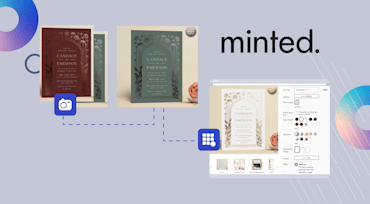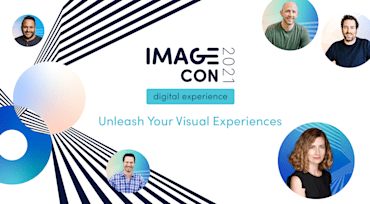Rising above the Noise with Visual Communication
The future of marketing depends on dynamic visual experiences. Marketers must connect with customers across multiple channels – the web, mobile, kiosks, email, search, and social as well as print and real time events. They must build brand awareness in increasingly noisy (and competitive) marketplaces. To rise above the noise, marketers must become well-versed in all things rich media -- using images, short and long form videos, and interactive contents in new ways to raise awareness, deliver powerful experiences, and boost engagement.
When it comes to day-to-day activities, marketers face competing priorities and shrinking time frames. They must incorporate rich media into one campaign, quickly determine what works, and have the agility to roll out additional campaigns in rapid succession. More and more, marketers have refined their workflows and rely on marketing tools and technologies to manage initiatives, personalize content delivery, and monitor results. At the same time, marketers struggle to do more with less – delivering compelling messages and generating quality leads while optimizing investments and lowering costs.
The Challenges for Dynamic Outreach
Dynamic visual experiences introduce new ways of working. Marketers must focus on both managing the digital assets and channeling how they are used. Consider how a marketing team faces the challenges of increasing its dynamic outreach by incorporating personalized video clips within upcoming campaigns.
- First, the team needs different clips for different target groups. Each clip visualizes the personalized experience for a particular audience. Where once one clip sufficed, now many more are needed.
- Next, video delivery must be optimized for the network connections and display resolutions of different digital channels. A compelling clip running in a full-screen web browser connected over WIFI may not perform well on a mobile browser using a congested cellular connection.
- Finally, what constitutes customer engagement varies. Success metrics might include clicking on a compelling video preview, watching the complete clip, or detecting predefined visual objects and sounds within the stream. Needed are smart capabilities for tracking multiple parameters.
The team is more likely to make video (and other types of rich media) a part of their digital campaigns when staffers can leverage their existing marketing technologies for managing these rich media assets and tracking results. Needed are capabilities to integrate images and other kinds of digital assets with related tools and processes.
Corralling Digital Assets
As the landscape for digital experiences becomes increasingly visual, marketers can no longer manage digital assets in the wild. Stand-alone files and networked file stores, running either in the cloud or on premises, are stop-gap remedies that do not scale. Marketers must corral their rich media files, add intelligence, and incorporate digital asset management (DAM) capabilities to their portfolio of marketing technologies.
Specifically, a DAM becomes the repository of record, the single source of truth for storing, organizing, securing, and delivering all kinds of digital assets within a networked environment. And as a repository of engagement, it links creative teams involved in rich media production with marketing teams charge with delivering and tracking experiences.
Videographers, photographers, graphic designers, musicians, and different editors and producers continue to do what they do best -- using their favorite creative tools to upload, cull, and edit assets, and produce them in final form, ready for distribution to marketing teams. Marketers then access this shared repository to update digital experiences and launch new campaigns, using their familiar web content management (WCM) platforms, campaign management applications, and other marketing automation tools. They can easily search for and select approved sets of digital assets as just another step within their marketing workflows.
When Headless DAM Supports Marketing Workflows
Many firms have already invested substantial time and effort developing workflows for rolling out competitive marketing programs. Ideally, delivering personalized images within a social media stream should be no different than targeting video clips. The marketing workflows should remain the same – only the media types are different. A next-generation DAM should augment familiar marketing initiatives.
In fact, marketing tools should rely on the capabilities of a “headless DAM,” deployed as a set of services and accessible in the cloud through standardized APIs. Marketers should be able to streamline rich media workflows and easily search for the right digital assets within the context of launching a campaign. They should be able to utilize the intelligent retrieval capabilities of their DAM to narrow their selections from very large collections, often encompassing millions of items. They should be able to deliver optimized digital experiences across multiple devices, regardless of network connections.
Speed to Market
In short, what counts for marketers is speed to market -- leveraging the velocity of experiences with the volume of digital assets. Making it easy to incorporate dynamic visual experiences into marketing campaigns transforms the initiatives themselves, and allows marketers to rise above the din of noisy marketplaces.
Further Reading on Digital Asset Management
- The Ultimate Digital Asset Management Guide
- Reimaging DAM: The next-generation solution for marketing & development
- Asset collaboration be DAM'd: A cross-organizational solution
- A unified approach to DAM across the asset lifecycle
- How a cloud-native DAM optimizes customer experiences
- Auto AI content recognition tagging in Cloudinary DAM
- Image fingerprinting identify similar images using pHash
- How to create attractive PDF thumbnails - for PDF cover page and internal pages
- An intuitive RESTful HTTP administrative API provides control to programmatically manage assets
- Learn how to leverage Cloudinary's cloud-based API for applying effects on images to automatically blur faces using the pixelate effect





